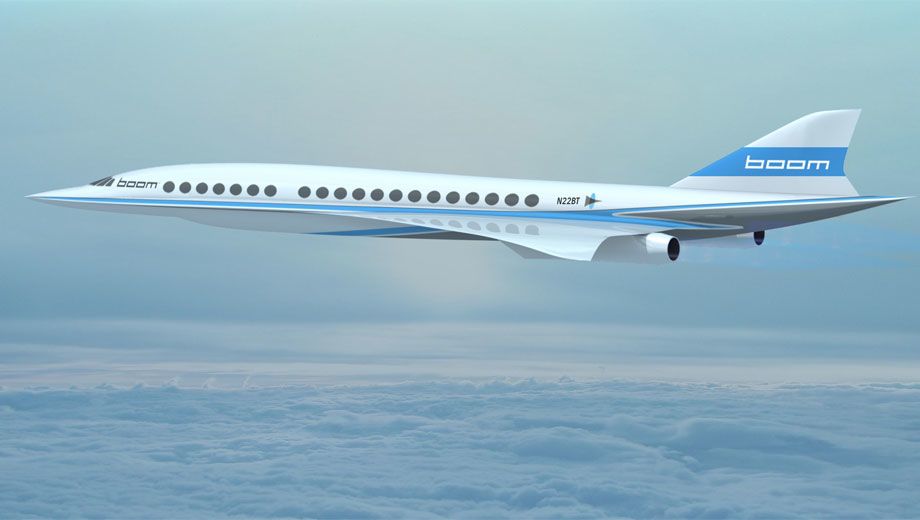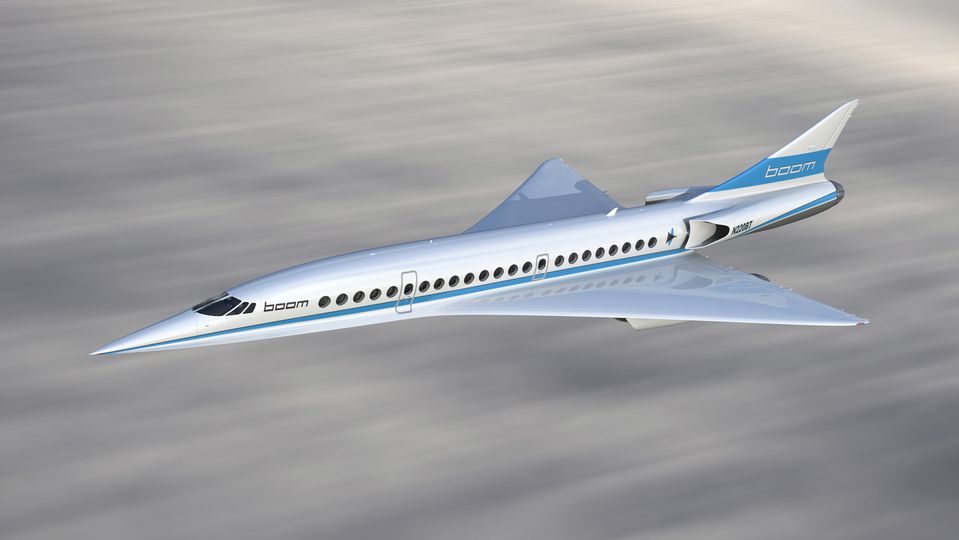Get ready for Virgin Supersonic as Richard Branson backs Boom jet

UPDATE | The return of commercial supersonic flights is one step closer following this week's reveal of the Boom XB-1 'supersonic demonstrator' in Colorado, USA.
Backed by Brit billionaire Sir Richard Branson, who has an option to buy the first 10 of these next-gen Concordes, this mockup 'Baby Boom' demonstrator is a scaled-down version of the full-sized XB-1 jet which aims to slash travel times on popular over-water routes like Sydney-Los Angeles and New York-London.
The Baby Boom is more akin to a private jet made for testing the Boom's new wave of supersonic technology, and is one-third the size of the final commercial XB-1 design (both planes are shown below).
The Sydney-Los Angeles route would become a seven-hour supersonic sprint – down from an average 13 hours today – at around US$3,500 (A$4,720) each way, although there's talk of a refuelling stop en route.
The trans-Atlantic dash between London and New York would take just over three hours, down from about an eight-hour flight, at US$2,500 (A$3,375) each way.
Those trips would be flown at just over twice the speed of sound at Mach 2.2, or about 2,700km per hour, compared to the Concorde's Mach 2 and conventional commercial jet speeds of 800km/h to 965km/h.
And Boom's passengers would enjoy a far superior experience to Concorde's cramped seating: the all-business class layout of 45 seats will provide plenty of legroom, just one seat either side of the centre aisle, and oversized windows to take in the view from 60,000 feet.
The seats themselves will offer ample space to work and relax, with inflight AC charging ports to keep your travel tech powered up.
Boom founder and CEO Blake Scholl says Boom will succeed where Concorde eventually failed because developments in technology and lighter materials will translate into much cheaper tickets which will make supersonic travel affordable to the mainstream.
"Sixty years after the dawn of the jet age, we’re still flying at 1960s speeds," Scholl says.
"I don't know a single person who wouldn't want to get there in half the time, rather than have some free champagne. It won’t be a bucket-list purchase any more. There is a huge market and the margins are enormous."
Scholl sees up to 500 global routes for Boom but will concentrate initially on New York-London, Los Angeles-Sydney and San Francisco-Tokyo.
"Ultimately I want people to be able to get anywhere in the world in five hours for $100. To get there you have to improve fuel efficiency, but step-by-step supersonic air travel will become available for everyone."
Boom plans to start testing its actual XB-1 prototype by the end of 2017 ahead of a launch for the full-size XB1 in 2023.
PREVIOUS | Virgin Galactic has called dibs on the first ten of a new breed of supersonic jets dubbed Boom, with Sir Richard Branson eager to kickstart a new revolution in affordable supersonic flights for business travel and high-end personal travel.
Although smaller than the legendary Concorde, the team behind Boom claim their supersonic jet – built using modern technology such as carbon-fibre composites – will be both quieter and faster.
Fast enough to dash between Sydney and Los Angeles in around six hours – slashing the current flying time in half, so you could leave Sydney at 6pm and still land at LAX around 6.30am local time.
That's almost too fast, given that you'd barely eke out four hours of sleep between take-off, supper, breakfast and landing – in other words, flying from Sydney (or Melbourne, or Brisbane) to Los Angeles would be more akin to catching a red-eye from Perth.
Of course, the very lucrative and low-hanging fruit is the London – New York route, which the Boom jet could clock in a Concorde-esque three and a half hours.
Boom's top speed of Mach 2.2 will bend the needle at 2,716km/h, with the jet soaring at 60,000 feet – almost half as much again as today's commercial flights – where it can slice through the thinner atmosphere while also providing passengers with a stunning view of the Earth's curvature.
But jettison thoughts of jetset luxury: the reality of bums-on-seats economics means that Boom will be fitted with standard (albeit very comfy) domestic-grade business class recliners rather than fully-flat beds.
The designers envisage just 40 seats in each single-class Boom jet, with a 1-1 layout so that every passenger gets both a window view and direct access to the aisle.
The Concorde, by comparison, carried 100 passengers in cramped 2-2 seating.
Virgin Galactic's interest is at present limited to options to buy the jets – at an estimated US$200 million (A$260 million) each – rather than firm orders.
But the boffins behind Boom are serious about their plans to usher in a new era for supersonic travel, and they're seriously cashed up, too.
They'll need to be.
The twelve years since Concorde's last flight has seen no shortage of inspired ideas for next-gen supersonics, however Boom's challenge is not only to build the jet from scratch but also to rebuild the commercial market for faster-than-sound travel.
"This isn't science fiction," says Boom founder and CEO Blake Scholl. "We're not using any technology that doesn't already exist, it is just putting it together in the right way."
The aim is to deliver supersonic speeds without astronomical airfares.
"This is supersonic passenger air travel... and it's actually affordable. 'The idea is for a plane that goes faster than any other passenger plane built before, but for the same price as business class. Our ultimate goal is routine supersonic flight for everyone."
The company hopes to wheel a working prototype out of the hangar by the end of 2017.
Photo gallery: Inside the British Airways Concorde
Follow Australian Business Traveller on Twitter: we're @AusBT










21 Apr 2012
Total posts 3012
I'm now waiting for the lame news<dot>com article appearing on the web for Australia to London flights in 10h. Of course followed by the anticipated Q&A on this website asking when non-stop flights between Australia and London will start :)
Qantas - Qantas Frequent Flyer
07 Feb 2015
Total posts 150
Yep, can see that coming soon...Although there must be a certain degree of demand if people continue asking for a non-stop Aus-London/Europe flight.
QFF
12 Apr 2013
Total posts 1518
10 hr is more than twice fast of current 24 hr, but it still way out of 3-4 hr comfort zone. For the same money I rather have a decent sleep in flat bed during 24 hour flight and arrive fresh and ready to go than sit upright even in very comfy seat for 10 hr and arrive with massive jetlag. SYD-LAX even more so. Of course YMMV.
31 Mar 2016
Total posts 621
10 hrs nonstop AU-London will have nothing to do with Boom/Virgin in whatever scenarios.
QFF
12 Apr 2013
Total posts 1518
In other word squarely aimed on LHR-JFK route. Fair enough - no-one cares about Ozzies anyway.
Qantas - Qantas Frequent Flyer
28 Sep 2011
Total posts 321
The name says it all. What constrained Concorde was the somic boom, and that will be the same here. The N wave for Concorde mach 2 @ 52,000ft was about 1.9 lb/ft2 I think, so quite strong. Still, Boom is a smaller aircraft and therefore less pressure. LON-JFK, LON-RIO, SYD-LAX, SYD-JNB and SYD-SCL are all mainly over water so would definitely work if demand is there. Qantas have a look?
Qantas - Qantas Frequent Flyer
21 Mar 2013
Total posts 132
Not sure Qantas would be prepared to risk their safety reputation in the short term. Flying at that speed opens up a lot of extra risks, and I can't see them being one of the early ones to see how it goes.
05 Oct 2011
Total posts 197
I think the bit about 6 hours being no more convenient than 12 from SYD>>>LAX is right on the mark. I am not sure where the sweetspot is but I doubt it will be acroos the Pacific to OZ.
Qantas - Qantas Frequent Flyer
26 May 2012
Total posts 159
My wife would rather go first class on a subsonic plane and have more time to enjoy the food, drink, comfort and benefits that go with it. That said there will still be a demand for it, as with Concorde.
20 May 2015
Total posts 581
In a world of video conferencing via Skype and other VOIP systems, I don't think there is as much need for "face to face" interaction in business any more. This may create far less need for supersonic jets.
Combined with the fact a lot of high-end travel tries to make the journey as much of a pleasure as the destination, I'm coming to think that when high end passengers get on a plane they'll want to "make a meal of it" so to speak.
That said, Boom is only 40 passengers, and can do longer and thinner routes than Concorde. The operating economics, if they're as good as claimed, will be impressive as hell.
Qantas - Qantas Frequent Flyer
11 Oct 2014
Total posts 692
Lets look at those 'operating economics' as shown, shall we?
Hmm, $7,000 round trip SYD-LAX-SYD. Comparable to existing fares, i'd say. 6hrs duration vs 15hrs? Good - a 60% time-saving. But .. a 40 seat Boom aircraft vs a 400 seat B777 or B747 or A380?
The Boom aircraft is said to cost approx $200m (RRP) vs B777 / A380 at approx $400m (RRP). That's an awfully high CASM rate in terms of invested capital per frame for an airline. You'd need to fly 10 Boom flights to accommodate the equivalent number (ie: one) B777 / B747 flight. A lot of things don't add up, IMO.
I would dearly wish the idea to succeed. However, on those base figures, I suspect that this is 'wish-listing' only.
If Concorde (a fine aircraft for it's time) taught us one thing, it is that 'time is valuable' and that people will pay (and pay handsomely) to avail themselves of the benefit of it. Further, the B747 was such a radical idea purely because it put 'mass transportation' within the realms of the everyday person - because of it's economics. Both Boom and Concorde are niche aircraft, which serve a specific purpose.
The passenger that travels ULH regularly values their time. The leisure traveller also gets bored with longhaul flights over 10hrs, so the market dynamics indicate that there should be a high level of popularity for a venture such as this. Reality says to me, that in this instance - as was the case with Concorde - that prices on those routes shown - would probably be double the estimations shown above. The sheer 'exclusivity' of the service would demand that.
And all of the above ignores the legislative restrictions of sound-barrier travel over major routes.
If this does succeed - and I hope it does, I'd love to see larger windows (a la B787). And for a 6hr flight, I can do without a full layflat seat.
QFF
12 Apr 2013
Total posts 1518
I fail to see that it any faster than Concorde that covers SYD-LAX in 6 hr as well.
QFF
12 Apr 2013
Total posts 1518
Also I would argue that 6 hr is longish in “conventional” recliner seat (I would prefer 3, max 4) and a bit short for flat bed (not an option with Boom) while current 14hr or so just about perfect for flat bed. I think I rather opt for “conventional” way unless they make it 3 hr or so for the same money as business. Or it should be significantly cheaper – current business class is very comfy, not like when they launched Concorde that was compete only with First and was positioned above it.
Qantas - Qantas Frequent Flyer
21 Aug 2014
Total posts 503
Excited to see this come, although I'm more excited for space flight!
Qantas - Qantas Frequent Flyer
28 Sep 2012
Total posts 132
Branson has bagged 10 of these.
He also bagged a dozen or so A380's when they were launched.
Anyone see a pattern with Mr Branson?
Qantas - Qantas Frequent Flyer
29 Apr 2011
Total posts 21
Much as I'd like to return to cruising at 58k+ feet there is a lot about this that doesn't add up.
BA's Concorde carried 100 pax, 25x2-2 (which I didn't find cramped at the time) and if Boom is to carry 40 pax in 20x1-1 you can imagine that the planes are a similar size. I don't know how much it cost to fly a Concorde across the Atlantic (ie not the ticket cost but the cost to fly the aircraft) but if (as I've seen claimed) Concorde struggled to make a profit with more expensive tickets than those in the article is Boom really going to be more than 3-4x more efficient?
Also no mention of how they will deal with the sonic boom problem that severely restricted where Concorde could fly at speed.
VIRGIN VELOCITY
03 Dec 2013
Total posts 7
Loved Concorde - even watching fly over London was beautiful - so hope this happens!
Air Canada - Aeroplan
02 Sep 2015
Total posts 16
I had the honour of working on Concorde 50 years ago, and when the design started the competition was 707 and DC8. Concorde was designed for comparable noise signatures, but the advent of the high BPR turbofan on 747, L1011 and DC10 made takeoff noise for a turbojet a major problem . An engine for a M2.2 aircraft would require a variable cycle engine, operating as a high BPR turbofan at takeoff and a pure jet at supersonic speeds. Development of such an engine would be much more complicated and expensive than today's engines , for a single application with very small numbers built. I can't see any of the major engine manufacturers being interested in this project. I am very suspicious about claims for a 6000 mile range, which would require a very large aircraft.
I well remember the anti Concorde hysteria, largely based in the US, and expect to see this again . Finally, Concorde seating was a very comfortable 2-2 with spacious seats, and flight time from LHR to JFK was the same as Ottawa to Calgary, about 1800nm
Qantas - Qantas Frequent Flyer
28 Oct 2011
Total posts 461
Concorde was not uncomfortable, but seating was more akin to what we would now call Premium Economy. It was nowhere near as good as domestic J is now, let alone the international F products with which it was competing. People who flew Concorde did so for the speed, not the comfort.
Qantas - Qantas Frequent Flyer
09 Feb 2015
Total posts 382
Great idea and good on them for giving it a go, but I will believe it when I see it.
Qantas - Qantas Frequent Flyer
27 Nov 2014
Total posts 51
Wonder what Boom's carbon footprint will look like. I'm already not a fan of the amount of CO2 I'm responsible for flying conventional aircraft. :(
Qantas - Qantas Frequent Flyer
28 Oct 2011
Total posts 461
.....then don't fly! Simple.
Qantas - Qantas Frequent Flyer
27 Nov 2014
Total posts 51
Well, regarding my personal circumstances, you have a point of course. But I'm still very curious about the overall environmental impact of supersonic vs subsonic aircraft.
31 Mar 2016
Total posts 621
Regardless of whether you like the potential option by Boom /Virgin Supersonic to cut your longhaul cruise duration in half @ roughly current J fare level or not, I suspect many folks didn't realize the huge developmental challenges still facing this and other competing civil supersonic projects(e.g. Aerion AS2, HyperMach SonicStar) today and @ least the nex 10yrs. This article reported the launch for the full-scale airliner version is planned in 2023(Assuming 1st test flight only, not even Rev$ service) by Boom/Virgin, I believe that's technically completely unrealistic.
Hi Guest, join in the discussion on Get ready for Virgin Supersonic as Richard Branson backs Boom jet